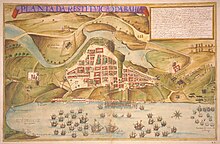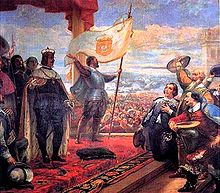Iberian Union
The kings from the Spanish branch of the House of Habsburg were the only element that connected the multiple kingdoms and territories, ruled by the six separate government councils of Castile, Aragon, Portugal, Italy, Flanders-Burgundy, and the Indies.
The Dutch Republic in turn saw the union as a justification to start targeting Portuguese colonies and would weaken Portugal's overseas empire in the Orient.
Some members of the Council of Governors of Portugal who had supported Philip escaped to Spain and declared him to be the legal successor of Henry.
The troops occupying the countryside (Tercios) commanded by Fernando Álvarez de Toledo, 3rd Duke of Alba arrived in Lisbon.
[9] The Duke of Alba imposed on the Portuguese provinces a subjection of Philip before entering Lisbon, where he seized an immense treasure; meanwhile, he allowed his soldiers to sack the vicinity of the capital.
António exploited the opportunity that the war between Elizabeth and Philip presented in order to convince the English to back an amphibious assault on Portugal in April 1589.
Both monarchs gave excellent positions to Portuguese nobles in the Spanish courts, and Portugal maintained an independent law, currency, and government.
The Consejo de Estado in Madrid, entrusted to declare on the major decisions that concerned the organization and the defense of the ensemble of the Hispanic monarchy, and it had frequently that to get into Portuguese matters.
Even, the Council of War (Consejo de Guerra) exercised its jurisdiction on the troops placed in the Castilian strongholds established on the Portuguese littoral.
So, Spain left the administration of Portugal and its empire largely to the Portuguese themselves, under general supervision from Madrid channeled through the viceroy in Lisbon.
These events, and those that occurred at the end of Aviz dynasty and the Iberian Union, led Portugal to a state of economic dependency on its colonies, first India and then Brazil.
War with the Dutch led to invasions of many countries in Asia, including Portuguese Ceylon (today's Sri Lanka), and commercial interests in Japan, Africa (Mina), and South America.
By a series of successful expeditions, he gradually extended the Dutch possessions from Sergipe in the south to São Luís, Maranhão in the north.
He likewise conquered the Portuguese possessions of Elmina Castle, São Tomé Island, and Luanda, Angola, on the west coast of Africa.
The Portuguese nobility began to lose its importance at the Spanish Cortes, and government posts in Portugal were occupied by Spaniards.
One of these was certainly the pressure from the center, especially from Gaspar de Guzmán, Count-Duke of Olivares, towards uniformity and sharing the financial and military burden of Castile's wars in Europe.
The moment was well chosen, as Philip's troops were at the time fighting the Thirty Years' War in addition to the previously mentioned revolution in Catalonia.
[25] Next, the king created the Junta of the Frontiers, to take care of the fortresses near the border, the hypothetical defense of Lisbon, and the garrisons and sea ports.
John IV also organized the army, established the Military Laws of King Sebastian, and developed intense diplomatic activity focused on restoring good relations with England.
By the time the war with France ended in 1659, the Portuguese military were well established and ready to confront the last major attempt of a worn out Spanish regime to reclaim control.
English soldiers were sent to Portugal and helped the Portuguese rout Don John's army at Ameixial near Estremoz on June 8, 1663.
Louis XIV sent French troops to Lisbon, and on 17 June 1665 the German General Frederick Schomberg led about 20,000 Portuguese forces to victory at Montes Claros near Vila Viçosa with only 700 killed and 2,000 wounded.
The Spanish city of Ceuta was a part of the Portuguese Empire until the end of the Iberian Union in 1640, after which it decided to remain with Spain.




